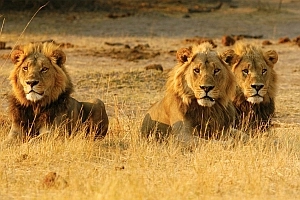The Moremi Game Reserve offers a year-round Botswana safari destination of approximately 5000km² (1,900 sq. mi) in the east corner of the Okavango Delta.
 Moremi Game Reserve (and its spectacular Khwai area) enjoys a wide diversity of habitat and is well known for the height of the trees in the mopane tongue, which covers the central area. However, the mainland part forms only about thirty percent of the reserve and is, in many ways untypical - the remaining area being part of the Okavango Delta.
Moremi Game Reserve (and its spectacular Khwai area) enjoys a wide diversity of habitat and is well known for the height of the trees in the mopane tongue, which covers the central area. However, the mainland part forms only about thirty percent of the reserve and is, in many ways untypical - the remaining area being part of the Okavango Delta.
The Khwai region was one of the first areas to offer photographic safaris and is known as one of the best safari areas in Botswana.
One of the must do activities in the Moremi Game Reserve is poling in a dugout canoe, called a mokoro through lagoons (of course, you don't have to do the poling, simply relax and enjoy the ride!).
Bird life is prolific and varied, ranging from water birds to shy forest dwellers (nearly 500 species). Elephants are numerous, particularly during the dry season, as well as a range of other wildlife species from buffalo, giraffe, lion, leopard, cheetah, wild dog, hyena, jackal and the full range of antelope, large and small, including the red lechwe. Rhino, both black and white, were here in the past, but most of the few remaining have been sought out for trans-location to the protection of a sanctuary, away from the attentions of illegal hunters.
One of the must do activities in the Moremi Game Reserve is poling in a dugout canoe, called a mokoro through lagoons (of course, you don't have to do the poling, simply relax and enjoy the ride!).
Bird life is prolific and varied, ranging from water birds to shy forest dwellers (nearly 500 species). Elephants are numerous, particularly during the dry season, as well as a range of other wildlife species from buffalo, giraffe, lion, leopard, cheetah, wild dog, hyena, jackal and the full range of antelope, large and small, including the red lechwe. Rhino, both black and white, were here in the past, but most of the few remaining have been sought out for trans-location to the protection of a sanctuary, away from the attentions of illegal hunters.
Wild dog, whose numbers are so rapidly dwindling elsewhere, are regularly sighted in the Moremi and have been subject to a project being run in the area since 1989 so these animals are often seen wearing collars placed on them by the researchers. It is claimed that the Moremi area contains about thirty percent of all living wild dog.
Book your This email address is being protected from spambots. You need JavaScript enabled to view it. now.
Book your This email address is being protected from spambots. You need JavaScript enabled to view it. now.
